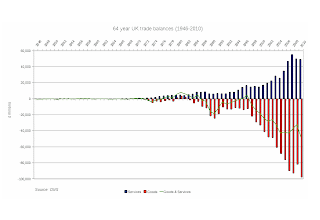UK residential housing sale volumes -Apr 2011
UK house sales are recorded by Her Majesties' Revenue and Customs (HMRC) when they collect stamp duty from the purchaser in each residential home transaction. They publish these figures as volumes. The figures are reliable, as solicitors alway make the payments to HMRC, so every transaction (over £40,000) is captured, today that means almost every transaction.
What they show is that volumes before 2008 were around twice what they are today. The figures above are real figures, not subject to seasonal-adjustment, which is why they are 'bumpy'.
Figures from before 2005 are not available, as HMRC does not seem to publish them, and perhaps never collected the information.
House prices (like wages, as Keynes pointed out) are sticky, which is to say that they do not drop easily, even when there is economic pressure for them to drop. As the house valuations and wages are both the result, mainly, of the same minds, perhaps this is not all that surprising. Even so, with volumes at half what they were before 2008, it is a wonder that they are this sticky. Demand for residential homes has been falling since 2003, as I showed in [this post of mortgage numbers]. This is now getting on for 8 years. If we add the falling number of mortgage-holders with the reduced number of existing mortgage-holders moving house - prices really should be much lower. This is what we might expect anyway in a market whose fiat currency exchanges were 'economic', dare I say it, 'rational'?
It is of course not rational, any more than the participants in this market (the householder, and would-be householder, the emigrant, and the deceased representatives) are rational. They are all wedded to a view that has been peddled by the industry for years, nearly a decade. Repeat after me "there is a shortage of houses", "everyone has a right to own their home".
What they show is that volumes before 2008 were around twice what they are today. The figures above are real figures, not subject to seasonal-adjustment, which is why they are 'bumpy'.
Figures from before 2005 are not available, as HMRC does not seem to publish them, and perhaps never collected the information.
House prices (like wages, as Keynes pointed out) are sticky, which is to say that they do not drop easily, even when there is economic pressure for them to drop. As the house valuations and wages are both the result, mainly, of the same minds, perhaps this is not all that surprising. Even so, with volumes at half what they were before 2008, it is a wonder that they are this sticky. Demand for residential homes has been falling since 2003, as I showed in [this post of mortgage numbers]. This is now getting on for 8 years. If we add the falling number of mortgage-holders with the reduced number of existing mortgage-holders moving house - prices really should be much lower. This is what we might expect anyway in a market whose fiat currency exchanges were 'economic', dare I say it, 'rational'?
It is of course not rational, any more than the participants in this market (the householder, and would-be householder, the emigrant, and the deceased representatives) are rational. They are all wedded to a view that has been peddled by the industry for years, nearly a decade. Repeat after me "there is a shortage of houses", "everyone has a right to own their home".



Comments
Post a Comment